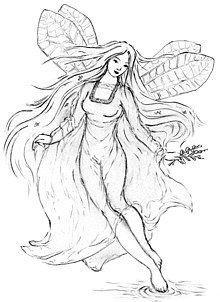Wila (mythology)
The Wila (also: Samowila , Samodiwa , Russian : вила , Ukrainian : віла , Polish : wiła , Czech : víla , Bosnian / Croatian / Serbian : vila ) is a female nature spirit in Slavic mythology . Wilen are described as group beings and predominantly associated with the water element, but also occur in forests, in the fields and in the mountains.
Prokopios of Caesarea already reports about their veneration within the framework of the pre-Christian cult in the 6th century. However, he does not name the Slavic name, but describes them as nymphs . Medieval Russian treatises bring her into connection with the goddess Mokosch . Their worship was an express part of church prohibitions in the 11th and 12th centuries. Modern ethnographic documents prove the belief in the Wilen especially in the south and east Slavic area, in Bulgaria a samovila festival was celebrated at Pentecost.
In the folk tales, Wilen are beautiful girls with transparent bodies and long hair. If they lose even a single hair, it means their death. Their dance places in the woods can be recognized by the trampled or tall grass or by mushrooms or strawberries that grow in a circle; entering them is considered dangerous. But they can also transform into animals and then appear in the form of a swan, a horse or a wolf. They are usually well-disposed towards people, even weddings between a Wila and a person appear in the stories. However, they take revenge for insults and can also confuse people and lead them astray. In Slovak folk belief, Wilen are revenants : brides who died before the wedding and cannot find peace in the grave. Dancing with them is life-threatening for a young man.
Related spirits are the Rusalkas , whose worship is closely linked to the cult of the dead and who, in contrast to the Wilen, are usually fatal.
In art, the motif of the dancing "Willis" was used as a legend from the Black Forest by Heinrich Heine in De l'Allemagne (1835) and Alphonse Karr in Les Willis (1856) and in the ballet opera Le Villi by Ferdinando Fontana (music by Giacomo Puccini ) and recorded in the ballet Giselle by Théophile Gautier .
See also
literature
- Naďa Profantová, Martin Profant: Encyklopedie slovanských bohů a mýtů . Nakladatelství Libri, Praha 2000, ISBN 80-7277-011-X .
- Zdeněk Váňa: Mythology and gods of the Slavic peoples. The spiritual impulses of Eastern Europe. (Original title: Svět slovanských bohů a démonů. ). Urachhaus, Stuttgart 1992, ISBN 3-87838-937-X .
- Zora Devrnja Zimmerman: The Changing Roles of the “Vila” in Serbian Traditional Literature. In: Journal of the Folklore Institute, Volume 16, No. 3, September-December 1979, pp. 167-175
